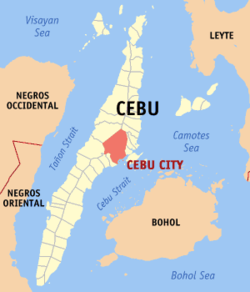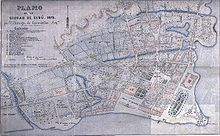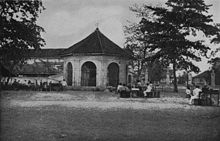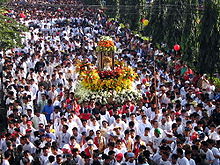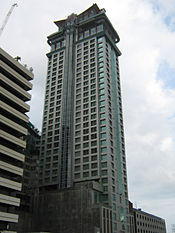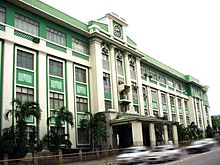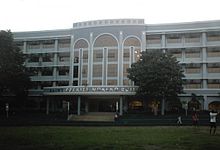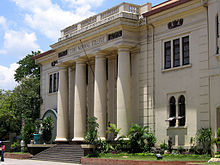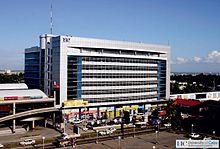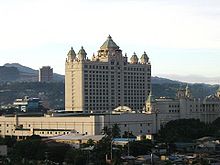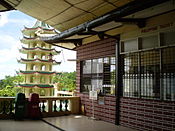- Cebu City
-
City of Cebu
Dakbayan sa Sugbo— City — 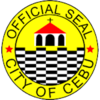
SealNickname(s): Queen City of the South
The Gateway To A Thousand Journeys
Island of the Pacific
Oldest Spanish Settlement in Asia
Financial Capital of Southern Philippines
City of Fashion and Designs
ASEAN City of Culture/ ASEAN Cultural City
First Asian Christian City
Heart of Visayas
Most Visited Tourists Destination of the PhilippinesMap of Cebu showing the location of Cebu City Coordinates: 10°17′N 123°54′E / 10.283°N 123.9°E Country Philippines Region Central Visayas (Region VII) Province Cebu (capital) Districts First (North) and Second (South) districts of Cebu City Barangays/Barrios 80 Spanish colonial foundation 1565 Reincorporated city February 24, 1937 Government - Mayor Michael Rama (BOPK–Liberal) - Vice Mayor Joy-Augustus G. Young (BOPK–Liberal) Area - Total 315.0 km2 (121.6 sq mi) Elevation 17.0 m (56 ft) Population (2009) - Total 822,628 - Density 2,611/km2 (6,762.5/sq mi) Time zone PST (UTC+8) Area code(s) 32 Website cebucity.gov.ph The City of Cebu (Cebuano: Dakbayan sa Sugbo) is the capital city of Cebu and is the second largest city in the Philippines, the second most significant metropolitan centre in the Philippines and known as the oldest settlement established by the Spaniards in the country.
The city is located on the eastern shore of Cebu and was the first Spanish settlement in the Philippines. Cebu is the Philippines' main domestic shipping port and is home to about 80% of the country's domestic shipping companies. Cebu also holds the second largest international flights in the Philippines and is a significant centre of commerce, trade and industry in the Visayas and Mindanao regions. According to the 2009 LGPMS census, the city has a population of about 822,628 people.
Cebu City is the centre of a metropolitan area called Metro Cebu, which includes the cities of Mandaue, Lapu-Lapu and Talisay. Metro Cebu has a total population of about 2 million people. The Mactan-Cebu International Airport, located in Lapu-Lapu City is only a twenty-minute drive away from Cebu City. To the northeast of the city are Mandaue City and the town of Consolacion, to the west are Toledo City, the towns of Balamban and Asturias, to the south are Talisay City and the town of Minglanilla. Across Mactan Strait to the east is Mactan Island where Lapu-Lapu City and an aquarium attraction are located.
Contents
History
On April 7, 1521, Portuguese explorer Ferdinand Magellan landed in Cebu. He was welcomed by Rajah Humabon, the king of Cebu, who together with his wife and about 700 native islanders, were converted into Catholicism on April 14, 1521. Magellan, however, was killed in the Battle of Mactan, and the remaining members of his expedition left Cebu soon after several of them were treacherously poisoned by Humabon.
On February 13, 1565, Spanish conquistadors led by Miguel López de Legazpi (together with Augustinian friar Andrés de Urdaneta) arrived in Cebu, but left after clashing with hostile natives. After visits to Mazaua, Leyte, and Bohol the Spanish returned to Cebu on April 15, 1565. They then attempted to parley with the local ruler, Rajah Tupas, but found that he and the local population had abandoned the town. Thus bereft, the conquistadors sacked the town and seized the island for Spain. Rajah Tupas presented himself at their camp on May 8, and the Treaty of Cebu was formalized on July 3, 1565. López de Legazpi's party named their new colony "Villa de San Miguel" (later renamed "Villa del Santísimo Nombre de Jesús)." In 1567 their numbers were reinforced by the arrival of 2,100 Spaniards and Mexicans. The growing colony was then fortified with the Fuerza de San Pedro.
By 1569 the Spanish settlement in Cebu had become important as a safe port for ships from Mexico and as a jumping-off point for further exploration of the archipelago. Small expeditions led by Juan de Salcedo went to Mindoro and Luzon, where he and Martín de Goiti played a leading role in the subjugation of the Kingdoms of Tundun and Seludong in 1570. One year later, López de Legazpi departed Cebu to discuss a peace pact with the defeated Rajahs. An agreement between the conquistadors and the Rajahs to form a city council paved the way for the establishment of a new settlement and the construction of the walled city of Intramuros on the razed remains of Seludong.
On August 14, 1595, Pope Clement VIII created the diocese of Cebu as a suffragan to the Archdiocese of Manila.
On April 3, 1898, local revolutionaries led by the Negrense Leon Kilat rose up against the Spanish colonial authorities and took control of the urban center after three days of fighting[citation needed]. The uprising was only ended by the treacherous murder of Leon Kilat and the arrival of soldiers from Iloilo.
The signing of the Treaty of Paris at the end of the Spanish-American War provided for the cession of Cebu along with the rest of the Philippine islands to the United States of America. On February 21, 1899 the USS Petrel (PG-2) deployed a landing party of 45 men on the shores of Cebu; the Cebuanos surrendered almost immediately. Cebu’s surrender to the Americans was signed by Luis Flores, although others, most notably, Gen. Arcadio Maxilom and Juan Climaco, offered resistance until 1901[citation needed].
Cebu only became a chartered city in February 24, 1937, during the Commonwealth Era (1935-1946). Many Philippine cities such as Dansalan (now Marawi), Iloilo City, and Bacolod City were only incorporated as such at that time (see Cities of the Philippines). Until then, Cebu City had never been more than a town since its original founding in 1565.
The city, along with the rest of the country came under Japanese occupation during WWII. The Japanese encountered some opposition there from guerrillas led by Col. James Cushing and the Cebu Area Command. It was finally liberated on March 1945.
Climate
Climate data for Cebu Month Jan Feb Mar Apr May Jun Jul Aug Sep Oct Nov Dec Year Average high °C (°F) 29.9
(85.8)30.2
(86.4)31.2
(88.2)32.3
(90.1)33.0
(91.4)32.1
(89.8)31.7
(89.1)31.9
(89.4)31.7
(89.1)31.6
(88.9)31.2
(88.2)30.3
(86.5)31.43
(88.57)Daily mean °C (°F) 26.8
(80.2)27.0
(80.6)27.8
(82.0)28.8
(83.8)29.4
(84.9)28.7
(83.7)28.3
(82.9)28.4
(83.1)28.3
(82.9)28.1
(82.6)27.9
(82.2)27.3
(81.1)28.07
(82.52)Average low °C (°F) 23.8
(74.8)23.7
(74.7)24.4
(75.9)25.4
(77.7)25.9
(78.6)25.3
(77.5)24.9
(76.8)25.0
(77.0)24.8
(76.6)24.7
(76.5)24.7
(76.5)24.2
(75.6)24.73
(76.52)Rainfall mm (inches) 78.1
(3.075)62.3
(2.453)41.5
(1.634)29.1
(1.146)54.8
(2.157)149.9
(5.902)157.0
(6.181)136.5
(5.374)167.3
(6.587)148.4
(5.843)131.4
(5.173)103.8
(4.087)1,260.1
(49.61)Source: Hong Kong Observatory [1] Culture
Cebu City is a significant cultural centre in the Philippines. The imprint of Spanish and Roman Catholic culture is evident. The city's most famous landmark is Magellan's Cross. This cross, now housed in a chapel, is reputed to have been planted by Ferdinand Magellan (Fernão Magalhães) when he arrived in the Philippines in 1521. It was encased in hollow tindalo wood in 1835 upon the order of the Augustinian Bishop Santos Gómez Marañon to prevent devotees from taking it home chip by chip. The same bishop restored the present template or kiosk, located at the present Magallanes street between the City Hall and Colegio del Santo Niño. Revered by Filipinos, the Magellan's Cross is a symbol of Christianity in the Philippines.
A few steps away from the Magellan's Cross is the Basilica Minore del Santo Niño (Church of the Holy Child). This is an Augustinian church elevated to the rank of Basilica in 1965 during the 400th year celebrations of Christianity in the Philippines, held in Cebu. The church, which was the first to be established in the islands, is built of hewn stone and features the country's oldest relic, the figure of the Santo Niño de Cebu (Holy Child of Cebu).
This religious event is celebrated during the island's cultural festivities known as the Sinulog festival. Held every third Sunday of January, it celebrates the festival of the Santo Niño, who was formerly considered to be the patron saint of Cebu. (This patronage was later changed to that of Our Lady of Guadalupe after it was realised that the St. Nino could not be a patron saint because he was an image of the Christ and not a saint.) The Sinulog is a dance ritual of pre-Hispanic indigenous origin. The dancer moves two steps forward and one step backward to the rhythmic sound of drums. This movement resembles somewhat the current (sulog) of the river. Thus, the Cebuanos called it Sinulog.
When the Spaniards arrived in Cebu, the Italian chronicler, Antonio Pigafetta, sailing under convoy with the Magellan expedition, offered a baptismal gift to Hara Amihan, wife of Rajah Humabon. She was later named Juana, the figure of the Santo Niño. The natives also honored the Santo Niño de Cebu in their indigenous Sinulog ritual[citation needed]. The Sinulog ritual was preserved but limited to honoring the Santo Niño. Once the Santo Niño church was built in the 16th century, the Christian Malay people started performing the Sinulog ritual in front of the church, the devotees offering candles and indigenous dancers shouting "Viva Pit Señor!"[citation needed].
In the 1980s and 2000s, the city authorities of Cebu added the religious feast of Santo Niño de Cebú during the Sinulog Festival to its cultural event.
Government
Cebu City is a highly-urbanized city, which makes itself independent of Cebu province, despite hosting the province's capitol. Its voters do not vote for provincial officials. There were proposals however during the time of Governor Emilio Mario Osmeña to establish an "administrative district" that would be independent from Cebu City. This would literally mean carving out Cebu City's Barangay Capitol where the provincial capitol and other provincial offices are located. The plan however didn't push through and was even followed by other proposals like the transfer of the capital to Balamban.
Cebu City is governed by a mayor, vice-mayor and sixteen councilors (eight representing the northern and eight representing the southern region). Each official is elected publicly to a three year term. The chief of the Association of Barangay Captains and the President of the Sangguniang Kabataan Federation also managed in the city council. The day to day administration of the city is handled by a city administrator.
Michael Rama is the mayor of the city. The former vice mayor was elected during the 2010 Philippine elections, meanwhile Joy-Augustus G. Young is the vice mayor.[2][3]
Current city officials (2010-2013)
- House of Representatives
- 1st District (North): Rep. Rachel "Cutie" B. Del Mar
- 2nd District (South): Rep. Tomas "Tommy" R. Osmeña
- City Mayor: Hon. Michael L. Rama
- Vice Mayor: Hon. Joy Augustus G. Young
Economy
Cebu City is considered as one of the most progressive cities in the Philippines. About 80 percent of the island vessels operating in the country are also based there. Recently, the entry of business process outsourcing (BPO) firms such as call centres have contributed much to the growth of the local economy. BPO sites are scattered throughout the city. During the last years of the 1980s, growth has been spread to the countryside. Thus, the name "Queen City of the South" was assumed. Aside from shellcrafts, rattan furnitures and stonecraft, tourism may well rake in dollars.
Geography and People
Cebu City has a land area of 291.2 square kilometres and about 55.9 square kilometres is classified as urban, while 235.2 square kilometres is classified as rural, although all barangays are classified as urban. To the northeast of the city are Mandaue City and the town of Consolacion, to the west are Toledo City, the towns of Balamban and Asturias, to the south are Talisay City and the town of Minglanilla. Across Mactan Strait to the east is Mactan Island where Lapu-Lapu City is located. Further east across the Cebu Strait is the Island of Bohol.
Population Census Census Pop. Rate 1995 662,299 — 2000 718,821 1.77% 2007 799,762 1.48% Around the 1960s, the population of the city was about 91,000. The current data shows that the population reached 799,762 people in 2007.
The city is politically subdivided into 80 barangays or barrios. These are grouped into two congressional districts, with 46 barangays or barrios in the northern district and 34 barangays or barrios in the southern district.
Barangays
Cebu City is politically subdivided into 80 barangays.
North district
- Adlaon
- Agsungot
- Apas
- Bacayan
- Banilad
- Binaliw
- Budla-an
- Busay
- Cambinocot
- Capitol Site
- Carreta
- Cogon Ramos
- Day-as
- Ermita
- Guba
- Hipodromo
- Kalubihan
- Kamagayan
- Kamputhaw (Camputhaw)
- Kasambagan
- Lahug
- Lorega San Miguel
- Lusaran
- Luz
- Mabini
- Mabolo
- Malubog
- Pahina Central
- Pari-an
- Paril
- Pit-os
- Pulangbato
- Sambag 1
- Sambag 2
- San Antonio
- San José
- San Roque
- Santa Cruz
- Santo Niño
- Sirao
- T. Padilla
- Talamban
- Taptap
- Tejero
- Tinago
- Zapatera
South district
- Babag
- Basak Pardo
- Basak San Nicolas
- Bonbon
- Buhisan
- Bulacao Pardo
- Buot-Taup Pardo
- Calamba
- Cogon Pardo
- Duljo-Fatima
- Guadalupe
- Inayawan
- Kalunasan
- Kinasang-an Pardo
- Labangon
- Mambaling
- Pahina San Nicolas
- Pamutan
- Pasil
- Poblacion Pardo
- Pung-ol-Sibugay
- Punta Princesa
- Quiot Pardo
- San Nicolas Proper
- Sapangdaku
- Sawang Calero
- Sinsin
- Suba San Nicolas
- Sudlon I
- Sudlon II
- Tabunan
- Tagba-o
- Tisa
- To-ong Pardo
Infrastructure
The city is readily accessible by air via the Mactan-Cebu International Airport located in Lapu-Lapu City which has direct international flights to Hong Kong, Malaysia, Singapore, Japan, China, Qatar, South Korea and domestic destinations. Many international and cargo airlines fly to Cebu. There are also direct transfer flights via the capital's Ninoy Aquino International Airport that readily connects the city to other destinations in the world. The city mostly gets its power from an interconnection grid with the Leyte Geothermal Power Plant which also powers the majority of the Visayas Islands. There are also coal-fired power plants, though these have been controversial due to their environmental impact. Another coal-fired power plant is nearing completion and is envisioned to make the city independent from the interconnection grid once completed.
The city is served by a domestic and international port which are handled by the Cebu Port Authority. Much of the city's waterfront is actually occupied by the port with around 3.5 kilometres of berthing space. The city is home to more than 80% of the country's island vessels traveling on domestic routes mostly in the Visayas and Mindanao.
The South Road Properties (SRP) is a 300-hectare prime property development project on a reclaimed land located a few metres off the coast of Cebu's central business district. It is registered with the Philippine Economic Zone Authority (PEZA) and is funded by the Japan Bank for International Cooperation(JBIC).[4] Traversing the property is a 12 kilometres, four-lane highway known as the Cebu Coastal Road that provides the motorists with a good view of Cebu's south coast and the nearby island of Bohol.
Telecommunication facilities, broadband and wireless internet connections are available and are provided by some of the country's largest telecommunication companies.
In the 1990s the Inayawan Sanitary Landfill was constructed to ease garbage disposal within the city. It is however nearing its lifespan although the Provincial Government is planning to build two sanitary landfills to serve both the northern and southern parts of Metro Cebu including Cebu City. In June 2005, the city fully implemented the segregation of wastes as mandated by law.
Mass transportation throughout the city and the metropolitan itself is provided by jeepneys, buses and taxis. The Cebu City Government conducted a feasibility study on implementing its Bus Rapid Transit System that will ease the transportation of the residents in the city and its neighboring cities like Mandaue, Lapu-Lapu, and Talisay. It has the same concept with the Metro Manila's Light Railway Transit System but it is more cost effective. This kind of mass transportation is popular in the Latin America and now it is implemented in the United States, Australia, and Indonesia. The project's first phase is expected to be operational in 2013. The remaining and additional phases is expected to be operational in 2015. The network will be passing to the Cebu Business Park, North Reclamation Area, South Road Properties, and Mactan-Cebu International Airport.
Shopping
- SM City Cebu
- Ayala Center Cebu
- Metro Gaisano
- Robinsons Place Cebu
- E-Mall
- Robinsons Maxilom (Planned)
- SM Seaside City SRP (U/C)
- S&R
- SM City Consolacion Cebu (U/C)
- Parkmall
- Gaisano Main & Country Mall
Education
Cebu City is one of three centres of education in the country, the others being Metro Manila and Davao City. It currently has nine large universities each with a number of college branches throughout the city and more than a dozen other schools specializing in various courses such as Medicine, Accountancy, Engineering, Nautical courses, Nursing, Law, Computer and IT and among others.Among these schools is the University of San Carlos. It has four campuses around the metropolitan area. It is currently headed by the Society of the Divine Word.
The University of the Philippines Cebu College, located at Barangay Camputhaw in the district of Lahug in Cebu City currently has 8 courses and has plans of expansion and development.
Another catholic university in Cebu City is the University of San Jose–Recoletos which was established in 1947. It is currently headed by the Augustinian Recollects and has 2 different campuses within the city excluding a new campus outside the city located in the Municipality of Balamban.
Cebu Normal University was established in 1915 as a provincial normal school, a branch of the Philippine Normal School. It became an independent institution in 1924, a chartered college in 1976 and a university in 1998. It is one of the oldest educational institutions in Cebu City.
One of the newest universities, the Cebu Doctors' University (formerly Cebu Doctors' College) was granted university status on November 2004. It is the only school in the Philippines declared as a university without having basic education (pre-school - high school) curriculum and catering mainly to courses related to the health services field. It has just recently relocated to a nine-storey main building at the Cebu Boardwalk in neighboring Mandaue City thus closing its old campus near the then Cebu Doctors' Hospital (now Cebu Doctors' University Hospital).
The University of Cebu in Banilad opened in June 2002, first had an eight-storey building. With the projected increase in enrollment in school year 2004-2005, a nine-storey building was constructed in the same area. The University of Cebu's main campus offers courses such as Bachelor of Science in Information Technology (BSIT), HRM, Computer Engineering, BSED and others.
Also located in the city is the University of the Visayas (the first-ever university in the city and in the entire province).
Other noteworthy institutions in the city includes the Asian College of Technology ,the Southwestern University, the Cebu Institute of Technology – University (the newest university in the city), the University of Southern Philippines Foundation in Lahug and Mabini,the Cebu Technological University (formerly the Cebu State College of Science and Technology), the Cebu Institute of Medicine(formerly the Velez College),the Sacred Heart School – Ateneo de Cebu(is a private, Catholic college preparatory school run by the Philippine Province of the Society of Jesus.),theCebu International School, and the St. Theresa's College of Cebu City.
The upcoming Centro Escolar University Cebu will be the fourth campus of the university after its Manila (Main), Malolos and Makati Campuses.
Many foreign students also travel to Cebu City to study. Most of them are Iranians and Nepalese who are studying medical courses. In recent years, many Koreans have come to Cebu to study English.
Cebu City has 68 public elementary schools, 23 national high schools and 28 night high schools. These night high schools are operated by the city government.
The Cebu City Public Library and Information Center is the only library in Cebu. It provides various sources of information for educational instruction and profitable entertainment to further the knowledge of people from all walks of life, young and old; professionals to laborers; and from students to teachers.
Tourism
The city derives significant income from tourism. It hosted the 1998 ASEAN Tourism Forum. The city also hosted the East Asian Tourism Forum on August 2002, in which the province of Cebu is a member and signatory.
There are a number of significant Spanish colonial buildings in Cebu City, including the Basilica Minore del Santo Nino, Fort San Pedro, Casa Gorordo Museum and Magellan's Cross.[5]
There are a number of shopping centres in the city.
Away from the city is the Cebu Taoist Temple, a Taoist temple in Beverly Hills. The Taoist Temple gives a commanding view of Cebu City and the nearby cities of Mandaue and Lapu-Lapu. Views of Cebu City can also be seen from villages and gated communities located on the mountains.
The beauty of Cebu City Philippines Temple of The Church of Jesus Christ of Latter-day Saints in Lahug marks the second of its kind in the Philippines after Manila Philippines Temple. Cebu City Philippines Temple serves Latter Day Saints from the island of Masbate, whole Visayas and Mindanao.
The Cebu Reggae Festival is a popular Filipino Reggae and Roots music festival, it now has become one of the Philippines' largest annual Reggae Festivals, in Cebu City. On Cebuano musical heritage, the Jose R. Gullas Halad Museum in V. Gullas St. (former Manalili) corner D. Jakosalem St. in Cebu City, holds musical memorabilia of Cebuano composers in the early 20th century, the likes of Ben Zubiri (composer of Matud Nila), Inting Rubi (Kasadya Ning Taknaa) and Minggoy Lopez (Rosas Pandan). The city also has a sport institution, the Cebu City Sports Complex which exhibits sporting and festival events.
Sister cities/towns
 Barcelona, Spain
Barcelona, Spain Salinas, California, USA
Salinas, California, USA Seattle, Washington, USA
Seattle, Washington, USA Chula Vista, California, USA
Chula Vista, California, USA St. Petersburg, Russia
St. Petersburg, Russia Ljubljana, Slovenia
Ljubljana, Slovenia Bandung, Indonesia
Bandung, Indonesia Kortrijk, Belgium
Kortrijk, Belgium Haarlemmermeer, Netherlands
Haarlemmermeer, Netherlands Yeosu, South Korea
Yeosu, South Korea Kaoshiung City, Taiwan
Kaoshiung City, Taiwan
See also
- List of parishes in Cebu
- Cagayan de Oro
References
- ^ "Climatological Normals of Cebu". Hong Kong Observatory. http://www.hko.gov.hk/wxinfo/climat/world/eng/asia/se_asia/cebu_e.htm. Retrieved 10 October 2011.
- ^ "Davide is acting Cebu City mayor Osmeña in US, Rama off to Korea". INQUIRER.net. http://globalnation.inquirer.net/cebudailynews/news/view/20081010-165704/Davide-is-acting-Cebu-City-mayor. Retrieved 10 October 2008.
- ^ "Osmeñas leave for US amid prayer". INQUIRER.net. http://globalnation.inquirer.net/cebudailynews/news/view/20081008-165293/Osmenas-leave-for-US-amid-prayers. Retrieved 8 October 2008.
- ^ "The Official Cebu City Government Forum". Republic of the Philippines: Cebu City Government. http://www.cebucity.gov.ph/srp/srp.htm. Retrieved 12 January 2010.[dead link]
- ^ Department of Tourism Philippines official website page on Cebu. Accessed 28 September 2009.
External links
- CebuCircle.com - Cebu City, Philippines
- Cebu City Government Website
- Philippine Standard Geographic Code
- 2000 Philippine Census Information
- 2007 Philippine Census Information
 Media related to Cebu City at Wikimedia Commons
Media related to Cebu City at Wikimedia CommonsCities Municipalities  Cities of the Philippines
Cities of the PhilippinesHighly-urbanized Cities Angeles · Bacolod · Baguio · Butuan · Cagayan de Oro · Caloocan · Cebu · Davao · General Santos · Iligan · Iloilo · Lapu-Lapu · Las Piñas · Lucena · Makati · Malabon · Mandaluyong · Mandaue · Manila · Marikina · Muntinlupa · Navotas · Olongapo · Parañaque · Pasay · Pasig · Puerto Princesa · Quezon City · San Juan · Tacloban · Taguig · Zamboanga
Independent
Component CitiesComponent Cities Alaminos · Antipolo · Bago · Bais · Balanga · Batangas · Batac · Bayawan · Baybay · Bayugan · Biñan · Bislig · Bogo · Borongan · Cabadbaran · Cabanatuan · Cadiz · Calamba · Calapan · Calbayog · Candon · Canlaon · Carcar · Catbalogan · Cauayan · Cavite · Danao · Dapitan · Dasmariñas · Digos · Dipolog · Dumaguete · El Salvador · Escalante · Gapan · Gingoog · Guihulngan · Himamaylan · Iriga · Isabela · Kabankalan · Kidapawan · Koronadal · La Carlota · Lamitan · Laoag · Legazpi · Ligao · Lipa · Maasin · Malaybalay · Malolos · Marawi · Masbate · Mati · Meycauayan · Muñoz · Naga, Cebu · Oroquieta · Ozamiz · Pagadian · Palayan · Panabo · Passi · Roxas · Sagay · Samal · San Carlos, Negros Occidental · San Carlos, Pangasinan · San Fernando, La Union · San Fernando, Pampanga · San Jose · San Jose del Monte · San Pablo · Santa Rosa · Silay · Sipalay · Sorsogon · Surigao · Tabaco · Tabuk · Tacurong · Tagaytay · Tagbilaran · Tagum · Talisay, Cebu · Talisay, Negros Occidental · Tanauan · Tandag · Tangub · Tanjay · Tarlac · Tayabas · Toledo · Trece Martires · Tuguegarao · Urdaneta · Valencia · Victorias · Vigan
Largest cities of Philippines
Philippines 2007 CensusRank City Name Region Pop. Rank City Name Region Pop. 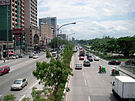
Quezon City
1 Quezon City Metro Manila 2,679,450 11 Dasmariñas CALABARZON 556,330 
Caloocan
2 Manila Metro Manila 1,660,714 12 Cagayan de Oro Northern Mindanao 553,966 3 Caloocan Metro Manila 1,378,856 13 Parañaque Metro Manila 552,660 4 Davao City Davao Region 1,363,337 14 Las Piñas Metro Manila 532,223 5 Cebu City Central Visayas 798,809 15 General Santos SOCCSKSARGEN 529,542 6 Zamboanga City Zamboanga Peninsula 774,407 16 Makati Metro Manila 510,383 7 Antipolo CALABARZON 633,971 17 Bacolod Western Visayas 499,497 8 Pasig Metro Manila 617,301 18 Muntinlupa Metro Manila 452,943 9 Taguig Metro Manila 613,343 19 Tagum Davao Region 450,526 10 Valenzuela Metro Manila 568,928 20 San Jose del Monte Central Luzon 439,090 Categories:- Cebu City
- Populated coastal places in the Philippines
- Populated places established in 1565
- Cities in the Philippines
- Former national capitals
- House of Representatives
Wikimedia Foundation. 2010.


